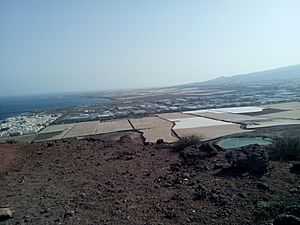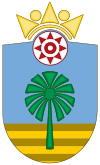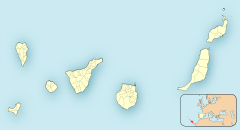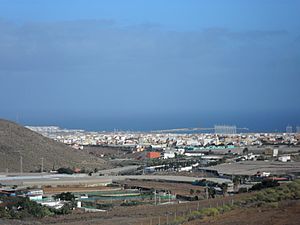Vecindario facts for kids
Quick facts for kids
Vecindario
|
|||
|---|---|---|---|
 |
|||
|
|||
| Country | Spain | ||
| Region | Macaronesia | ||
| Autonomous Community | Canary Islands | ||
| Province | Las Palmas | ||
| Island | Gran Canaria | ||
| Area | |||
| • Total | 61.56 km2 (23.77 sq mi) | ||
| Population
(2015)
|
|||
| • Total | 14,910 | ||
| • Density | 242.20/km2 (627.30/sq mi) | ||
| Time zone | UTC+0 (CET) | ||
| • Summer (DST) | UTC+1 (CEST (GMT +1)) | ||
| Postal code |
35110
|
||
| Area code(s) | +34 (Spain) + 928 (Las Palmas) | ||
Vecindario is a town located on the island of Gran Canaria. This island is part of the Canary Islands, which belong to Spain. Vecindario is found in the south-eastern part of Gran Canaria. It is part of a larger area called the municipality of Santa Lucía de Tirajana.
In 2015, about 14,910 people lived in Vecindario. However, if you include all the nearby areas, the population is closer to 70,000 people today! The current mayor of Vecindario is Dunia Gonzalez.
Vecindario is a very important town in its region. It is the third largest town on Gran Canaria by population. It is also the fifth largest in the entire Canary Islands group. Vecindario is about 35 kilometers (22 miles) from Las Palmas de Gran Canaria, which is the capital city of the island. It is also quite close to the Gran Canaria Airport (about 15 km or 9 miles away). The popular tourist area of Maspalomas is also only about 15 km away.
Vecindario is a central point for many towns along the coast. These towns include parts of Santa Lucía de Tirajana, Agüimes, and Ingenio. Together, these areas have about 120,000 people. Other towns in this group are Cruce de Arinaga, Playa de Arinaga, and Carrizal.
For a long time, farming was the main way people made money in Vecindario. They grew tomatoes and other vegetables to sell to other countries. But in the late 1900s, things changed. Now, most people work in services, especially in shops and businesses. Vecindario is now known as a huge outdoor shopping area on Gran Canaria. It has big shopping centers like C.C. Atlántico, and smaller ones like C.C. Mercacentro.
History
The town of Vecindario has an interesting history. Its name, which means "the neighborhood's land," came from a big argument. This argument was called the Agüimes mutiny. It happened because the people of Agüimes and a powerful person called the Count of the Vega Grande disagreed about who owned certain lands.
The people of Agüimes had been using these lands, but the Count said he had bought them. The people of Agüimes were part of the Bishopric (an area ruled by a bishop). They got help from a lawyer named Dr. Mendoza. He was very good at law. Dr. Mendoza proved that the Count's claim was false. He showed that the lands actually belonged to the people of Agüimes. They had been given the land in exchange for paying taxes.
Even in 1735, the people had not fully paid Dr. Mendoza for his help. So, they gave him a part of the Vecindario lands as payment. This area later became known as El Doctoral. A house called La Pinta was built there. Dr. Mendoza also said that some of the money made from another piece of land should go to help the Holy House of Jerusalem. Because of this, that place became known as the Holy House.
In 1815, the coastal areas, which included Vecindario and Sardina, joined with some inland lands. These lands had belonged to San Bartolomé de Tirajana. Together, they formed a new municipality called Santa Lucía de Tirajana.
See also
 In Spanish: Vecindario para niños
In Spanish: Vecindario para niños





